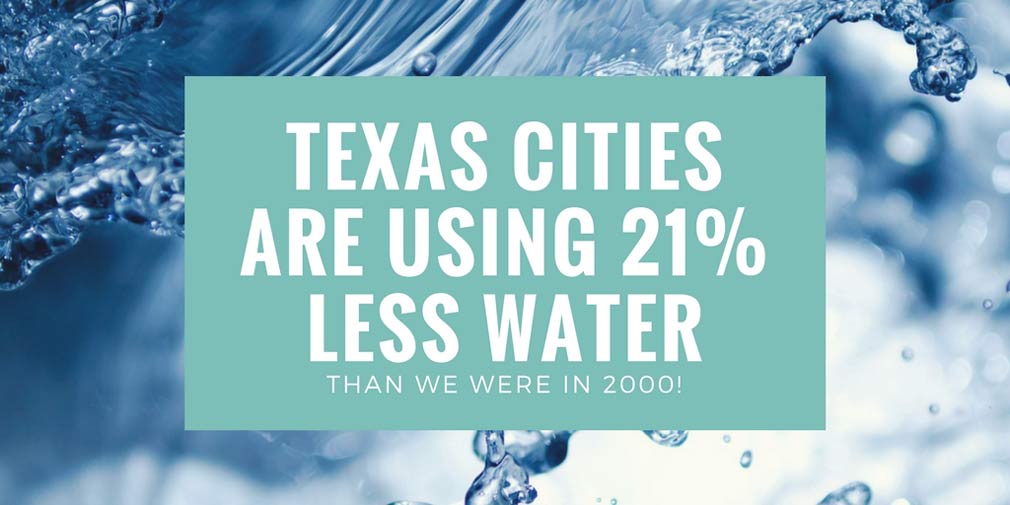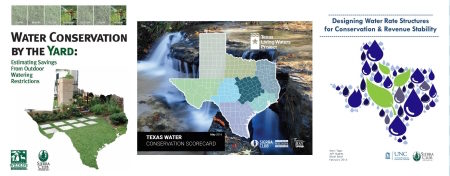[Originally published on the Texas Living Waters Project blog on Nov. 29, 2017]

By Jennifer Walker
I love to be the bearer of good news: Texans are making tremendous progress on conserving water. In fact, in the municipal sector (composed of residential, institutional, industrial, and commercial water use) cities across Texas are using 21 percent less water than we were in 2000.
One of the methods used to track water use is to calculate how much water is used per person each day, or gallons per capita per day (GPCD). Each Texas community tracks this data. Using this information, which is collected by the Texas Water Development Board, we found that the average municipal per capita water use in Texas dropped from 175 gallons per day in 2000 to 138 gallons per day in 2015. That adds up to a lot of water savings!
Many cities have stepped up to the plate in a big way to reduce water use. Check out our Texas Water Conservation Scorecard to see how your utility is doing.

This graph above shows that even as Texas’ population has risen, we have been able to use less water per person. This is thanks in large part to improved water conservation. Average use varies from year to year so while the trend is very positive, we have to keep at it.
How did we get here?
We have come a long way since 2000, with the Texas Living Waters Project’s water conservation education and advocacy efforts playing a big role while collaborating with other organizations, Texas leaders and water utilities with whom we have forged strong working relationships.
Here are just a few examples of the progress that has been made:
Set a goal – A 2004 state-appointed Water Conservation Implementation Task Force (of which Texas Living Waters’ leader Ken Kramer was a member) set a target for municipal water suppliers to reduce water use to 140 GPCD and called for a one percent reduction in water use each year to reach that target. Today, many major water suppliers have reached or exceeded that goal. The 140 GPCD goal set by the task force was actually a compromise; many members of the task force pushed for a goal of 125 GPCD.
Beat that goal – Average municipal per capita water use in Texas dropped from 175 gallons per day in 2000 to 138 gallons per day in 2015. That is a great start and with continued effort we can minimize year-to-year variation and move to 125 GPCD and beyond.
State water planning – Water conservation makes sense for Texas and state water planners are taking this strategy seriously in some parts of the state. In the 2017 State Water Plan, water efficiency strategies (conservation and drought management) are projected to meet about 32 percent of Texas’ water demands by 2070. Water Conservation strategies are almost always the most cost effective water supply options and are much easier on our environment than building new reservoirs, desalination plants, and other strategies.
The term ‘drought management’ may sound daunting, but it just means adding more stringent temporary restrictions on certain nonessential water-intensive activities like lawn watering and car washing during periods of drought. Reuse is another form of conservation strategy recognized in water planning. The current State Water Plan projects that 13% of our future water supply will come from reuse. Reuse doesn’t increase water efficiency, but, when carefully managed to protect river flows, it can prevent the need for other expensive and environmentally destructive new water supply projects.
Funding conservation – In 2013 the State of Texas for the first time earmarked a significant percentage (no less than 20 percent of the funds during each five-year cycle of funding) of its loan fund for water projects to go to water conservation and reuse through the State Water Implementation Fund for Texas (SWIFT). Check out our report, Navigating the SWIFT Application Process: Water Conservation Projects, designed to help Texas utilities take advantage of this under-utilized opportunity.
Working together – The Texas Living Water Project works closely with water utilities to advance conservation goals and design educational programs that will be effective and useful to conservation professionals. The regional water conservation symposia we help organize provide an affordable professional development option close to home for many water utilities. We are strongly committed to providing Texas water utilities with the research and tools that they need to plan and implement effective water conservation campaigns. Here are a few examples of our work:
- Texas Water Conservation Scorecard
- Water Conservation by the Yard: Estimated Saving from Outdoor Watering Restrictions
- Designing Water Rate Structures for Conservation and Revenue Stability
Becoming national leaders – As of 2014, Texas is one of three states in the U.S. (California and Georgia are the other two) to have the highest standards for water-efficient toilets. New toilets sold in Texas must use 1.28 gallons or less per flush. This is important because flushing toilets is responsible for about 31 percent of the average household’s indoor water use.
We have only begun to conserve
Does all of this good news mean we have achieved all that we can in Texas when it comes to water conservation? Not by a long shot.
We have only realized a fraction of the potential for conservation and drought-response measures that we will need to tap into to meet our state’s current and future water needs. Current population and future climate forecasts underscore the need to make more progress. The prospects for a hotter and drier climate for much of Texas mean that we need to stay focused on our efforts to become more efficient in our water use and more effective in our drought response. It is as simple as that.
Why does that matter? Because our future, our fish and wildlife heritage, the health of our bays and estuaries, and the well-being of our friends and neighbors depend on it. We must all do our part to help each other have a better future.
Good job Texas. Now back to work!
About Jennifer Walker - Water Resources Program Manager at Sierra Club - Lone Star Chapter
Jennifer has 15 years experience focusing on water policy issues in Texas with an emphasis on water planning, water conservation and bay and estuary protection issues. She and her family like to camp near rivers where they can listen to the frogs sing at night.
